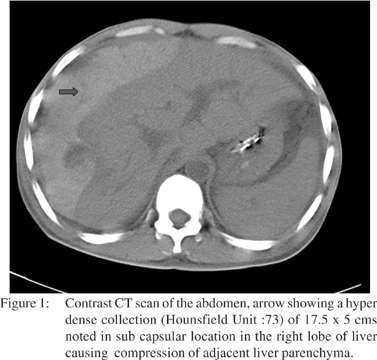48uep6bbphidvals|422
48uep6bbph|2000F98CTab_Articles|Fulltext
Introduction
Weil’s syndrome is the most severe form of leptospirosis, characterized by jaundice, renal failure and hemorrhagic diathesis. Here, we present a patient of Weil’s disease presenting with renal failure, jaundice and bleeding manifestations such as hemothorax, hemoperitoneum and sub capsular hematoma in the liver which is rare.
Case Report
A young male presented with short febrile illness, abdominal pain, yellowish discoloration of eyes and malena of one week duration. He was found to have severe renal failure, jaundice and leucocytosis. His coagulation parameters and platelets were within normal limits. He was positive for IgM leptospira by ELISA, serum microhemaglutination test (MAT) was positive for Leptospira hebdomadis with 1:100 titers. He was treated with saline (heparin free) hemodialysis, appropriate antibiotics and provided critical care support. He manifested later with hemorrhagic peritoneal and right sided pleural effusions and a massive sub capsular hematoma in the liver (Figure 1). The patient succumbed despite appropriate management.

Discussion
Leptospirosis is considered a re-emerging infectious disease throughout the world often needing multidisciplinary approach in management. Renal involvement is common and is observed in 44% - 67%.[1,2] Weil’s disease is a severe form of leptospirosis characterized by hepatic dysfunction, renal failure and hemorrhagic diathesis with about 46% cases requiring hemodialysis.[3] The mortality of patients who develop acute renal failure as part of severe leptospirosis is reported to be about 15-20% and remains high despite introduction of appropriate sophisticated support systems.[2,3] The exact mechanism involved in the damage of internal organs and blood vessels is not known, it has been postulated to be cytotoxin mediated endothelial cell damage leading to vasculitis with subsequent multiorgan dysfunction and increased capillary fragility.[2,4,5.6] Internal organ hemorrhage has been reported with fatal outcomes despite normal coagulation and platelet profiles.[7,8]
Hepatic hematoma as a manifestation of Weil’s disease is very rare in literature.It may be prudent to consider and monitor for bleeding diathesis despite normal coagulation and platelets status. Endothelial injury and vasculitis plays a major mechanism in bleeding diathesis and multi organ dysfunction warranting a multidisciplinary approach in management. This case is presented to highlight the very rare occurrence of spontaneous liver hematoma in Weil’s disease and also to be cautious in using heparin in hemodialysis during treatment of commonly encountered coexistent renal failure.
References
- Bharti AR, Nally JE, Ricaldi JN, Matthias MA, Diaz MM, Lovett MA, et al. Leptospirosis: a zoonotic disease of global importance. Lancet Infect Dis. 2003;3:757–71.
- Sitprija V, Losuwanrak K, Kanjanabuch T. Leptospiral Nephropathy. Semin Nephrol. 2003;23:42–8.3. Peces R. Acute renal failure in severe leptospirosis. Nephrol Dial Transplant. 2003;18:1235–6.
- Scott G, Coleman TJ. Leptospirosis. In: Cook GC, Zumin A, editors. Manson’s Tropical Diseases. 21st ed. London: ELST Saunders; 2003.p.1165–7.
- Wats G. Leptospirosis. In: Warrell DA, Cox TM, Firth JD, Benz EJ, editors. Oxford Textbook of Medicine. 4th ed. Oxford: Oxford university press; 2003.p.600–3.
- Wagenaar JF, Goris MG, Sakundarno MS, Gasem MH, Mairuhu AT, de Kruif MD, et al. What role do coagulation disorders play in the pathogenesis of leptospirosis? Trop Med Int Health. 2007;12:111–2.
- Theilen HJ, Luck C, Hanisch U, Ragaller M. Fatal intracerebral hemorrhage due to leptospirosis. Infection. 2002;30:109–12.
- Neligan A, Mullins GM, O’Sullivan SS, Fitzegerald P, Harrington P. A rare cause of fatal intracranial haemorrhage. Ir J Med Sci. 2009;178:343–5.